As days shorten and the rains return to coastal British Columbia, smart property managers treat fall as a strategic season—not a slowdown. It’s the perfect window to reduce risk, refresh curb appeal, and set sites up for lower costs in spring. Here are the fall landscaping trends we’re seeing across commercial properties in Greater Victoria and beyond, with examples from IslandEarth Landscape’s approach.
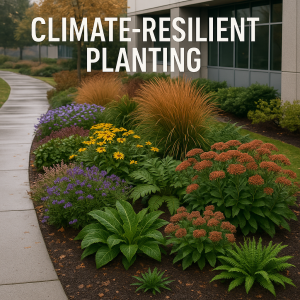
1) Climate-resilient planting takes center stage
After a dry, warm summer, fall is prime time to install plants that are tougher, more diverse, and better for local ecosystems. Expect to see perennial, drought-tolerant palettes that still deliver colour and structure through October and November: asters, rudbeckia, sedum (Hylotelephium) and ornamental grasses (Panicum, Calamagrostis) paired with BC natives like kinnikinnick, evergreen huckleberry, sword ferns, salal, and vine maple. Beyond looks, these choices reduce watering, support pollinators, and handle shoulder-season storms better than thirsty annuals.
IslandEarth example: At a Langford office park, we’re swapping high-maintenance annual beds for layered perennial borders—sedum and asters for late bloom, grasses for movement, and Oregon grape for evergreen backbone—cutting seasonal water needs and giving the site a more modern, textured look.
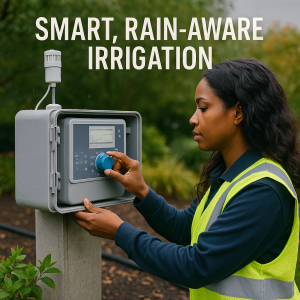
2) Smarter water: rain-aware controls and ‘right-sized’ irrigation
Fall brings rainfall—and opportunity. Sites are adopting rain-sensing and weather-based irrigation controllers, plus flow meters to catch leaks. The trend is to “right-size” systems during fall service: capping redundant heads, converting strips to drip, and tuning runtimes to soil and slope. In medians and narrow planters, dripline is becoming the default to reduce overspray and puddles that create slip hazards.
Pro tip: Use fall tune-ups to map zones and tag chronic wet spots. A two-hour audit now can prevent months of algae, moss, and walkway staining.
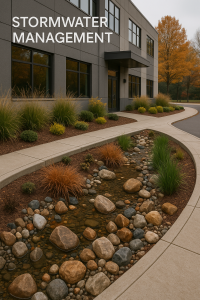
3) Stormwater management as a design feature
With heavier fall rain events, bioswales, rain gardens, and permeable hardscapes are moving from “nice to have” to “must have.” Properties are refreshing swales with deep-rooted natives (sedges, rushes, dogwood) and adding river rock accents that both slow runoff and look polished for tenants. Maintenance is equally important: clearing catch basins, re-establishing mulch, and checking grades so water actually reaches the places designed to hold it.
IslandEarth example: For a Saanich retail pad, we rebuilt a tired swale with layered plants and a cobble channel, then set a fall maintenance cadence (leaf checks after each major storm) to keep water moving and parking lots dry.
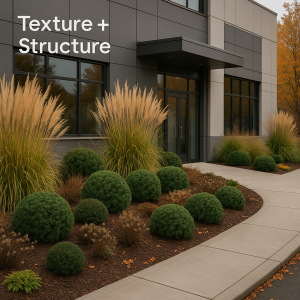
4) Texture + structure > short-lived colour
Seasonal “mums and pumpkins” displays aren’t gone, but the trend is to anchor entrances with long-view design: sculptural grasses, evergreen bones, and planters that can be updated with small, seasonal swaps. Textures read well on grey days and through winter: glossy salal, the vertical lines of feather reed grass, and the seedheads of coneflower and black-eyed Susan that also feed birds.
Design note: Plant in drifts for impact; avoid checkerboard mixes that get visual cluttered as leaves drop.
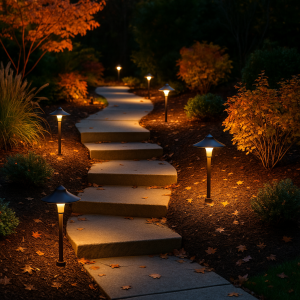
5) Battery-powered maintenance for quieter sites
Electrification continues to accelerate. Fall leaf work highlights the advantage of battery blowers and mowers—lower noise near offices, schools, and medical buildings, along with reduced emissions. Crews are standardizing on battery platforms with multiple packs per truck and on-site charging. For managers, it’s an easy ESG win and a better tenant experience during busy daytime hours.
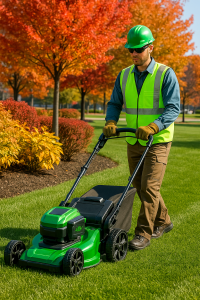
6) Safety-first lighting and wayfinding
Shorter days push exterior lighting into the spotlight. The trend is targeted LED upgrades: step lights on stairs, bollards along desire paths, and warm-white uplights on key trees. Motion sensors reduce energy use, while photometric planning eliminates dark pockets and glare. Wayfinding paint and reflective striping are getting refreshed in tandem, especially where leaf drop and rain combine to hide edges.
IslandEarth example: A Victoria tech campus layered path-edge bollards with canopy downlights, then added a maintenance plan to wipe lenses and re-aim fixtures each fall—small tasks that keep lighting effective all winter.
7) Leaf strategy: mulch, compost, and risk reduction
Rather than constant blowing, many sites are embracing “leaf logic”: mulch-mowing leaves into turf to return nutrients, while prioritizing hardscapes, drains, entrances, ramps, and accessible routes for zero-tolerance debris. Where volumes are high, leaves are chipped and added to on-site compost or used as protective mulch in shrub beds. This cuts hauling costs and builds soil health.
8) Biodiversity and “messy-managed” areas
A neat front door can coexist with ecologically rich corners. We’re seeing properties designate back-of-site strips for native meadow mixes, fallen log habitat, and seed-head retention through winter—clearly signed so tenants understand the intent. These zones boost pollinators, birds, and beneficial insects, aligning with corporate sustainability narratives without sacrificing a professional frontage.
9) Green walls and vertical accents for fall impact
Living walls aren’t just a summer feature. Cold-tolerant panels, evergreen climbers (like star jasmine in milder pockets or evergreen clematis), and modular planters are being used to turn blank facades into brandable, seasonal moments. In fall, designers are leaning on foliage contrast and berries rather than blooms, keeping irrigation tuned down and maintenance tight.
10) Data, documentation, and ESG reporting
Finally, properties are asking for quantifiable outcomes: water use reductions, green-waste diversion, and noise/emissions improvements from electric equipment. Fall is a great time to baseline these metrics, since you’re already touching every system. Crews deliver simple end-of-season reports with “before/after” photos, zone maps, and quick wins for spring budgeting.
Quick Fall Checklist for Property Managers
-
Schedule an irrigation audit and implement rain-based adjustments.
-
Refresh entrances with perennial texture; add a few seasonal highlights.
-
Pre-book storm response: leaf priorities, drain checks, and post-storm walk-throughs.
-
Upgrade critical path lighting and repaint wayfinding where needed.
-
Identify one biodiversity zone to manage “neatly natural,” with tenant signage.
-
Confirm battery equipment plan and charging logistics with your contractor.
-
Capture metrics (water, green waste, noise) for ESG and 2026 planning.
If you’d like a site-specific fall plan, IslandEarth can walk your property, map quick wins, and stage work so you see immediate safety and aesthetic gains before winter—while setting up smarter water and lower maintenance for spring.